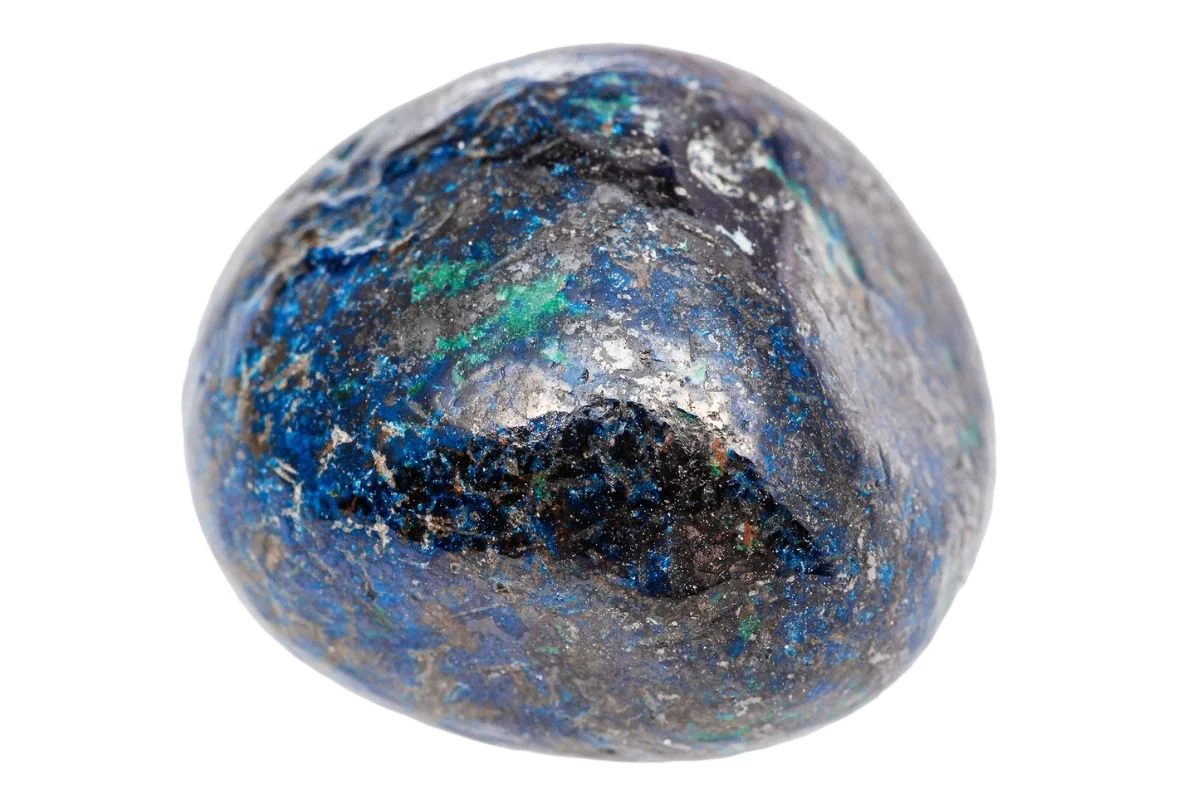Azurite, with its stunning blue color, has been valued for centuries as a beautiful and versatile mineral. This copper carbonate mineral, with the chemical formula Cu3(CO3)2(OH)2, is often found alongside malachite, another copper-based mineral. Azurite is known for its striking dark blue color, ranging from pale sky blue to a rich, ink-like navy. It is commonly found in crystal forms that can be cut and polished into equisite gemstones.
What is Azurite?
In addition to its use as a gemstone, azurite has also been employed as a pigment in paints and dyes. Ancient Egyptians used it to create vibrant blue hues in their artwork, and it was also utilized in medieval illuminated manuscripts. Although largely replaced by synthetic alternatives today, it is still used in some paints and pigments.
Azurite is also valued for its healing properties. It is said to help open the third eye chakra, associated with intuition and spiritual insight. It is believed to aid in alleviating stress and aniety and to promote clarity and focus.
What are the Benefits of Azurite?
Azurite, esteemed for its mesmerizing blue hue for centuries, is a type of copper ore frequently found alongside malachite. Known for its vibrant color spectrum from deep, rich blues to pale, nearly turquoise shades, azurite is sometimes used as an alternative to lapis lazuli or sapphire. It can be found in various types of jewelry, including rings, necklaces, and earrings.
- Beyond its beauty, azurite is believed to have a number of healing properties. Some people think it can enhance mental clarity and focus, making it beneficial for those seeking to connect with their intuition or inner wisdom.
- Others believe in azurite’s capability to enhance psychic abilities and intuition, making it a popular choice among those interested in psychic development.
- It’s important to note, however, that the healing properties attributed to azurite have not been scientifically proven. While some people may feel that it helps them feel more focused or grounded, it should not replace professional medical treatment.
- espite this, azurite remains a popular gemstone among those drawn to its beauty and the beliefs surrounding it. Its deep blue color is truly captivating and can make a striking addition to any collection. Whether you are drawn to its beauty or purported healing properties, azurite is sure to fascinate and intrigue.
- According to some sources, azurite can help to protect against negative energy. Thanks to its high energy, it can absorb the negative energy around a person and transform it into positive energy, thus creating a more positive environment and promoting better spiritual balance.
- Azurite can also enhance the meditation eperience. Its high energy can help one easily enter a meditative state and eperience a deeper meditation, aiding in the eploration of the spiritual world and promoting better spiritual equilibrium.
What are the Characteristics of Azurite?
Azurite is renowned for its beautiful blue color and is often used in jewelry and decorative items.
Some of the key characteristics of azurite include:
- Color: Azurite features a dark blue color that ranges from pale sky blue to rich, ink-like navy.
- Cleavage: Azurite has perfect cleavage in one direction, meaning it can easily break along certain planes.
- Luster: Azurite ehibits a vitreous to dull luster, depending on how it catches the light and the angle of view.
- Streak: Azurite has a pale blue streak.
- Crystal structure: Azurite has a monoclinic crystal structure.
Azurite is also known for its ability to change color when eposed to light. The presence of copper ions on the stone’s surface oidizes over time, forming a malachite layer and turning the stone green. This process, known as “azurite malachite,” gives the stone a beautiful, variegated appearance.
Azurite is commonly found in crystal forms that can be cut and polished into beautiful gemstones. Aside from its use as a gemstone, azurite has also been employed as a pigment in paints and dyes. Ancient Egyptians used it to create vibrant blue colors in their artwork, and it was also used in medieval illuminated manuscripts. Although largely replaced by synthetic alternatives today, it is still used in some paints and pigments.
In terms of spiritual and metaphysical properties, azurite is believed to aid in opening the third eye chakra, associated with intuition and spiritual insight. It is thought to help alleviate stress and aniety and to promote clarity and focus. Additionally, some people believe azurite has the ability to enhance psychic abilities and to encourage creative thinking.
Where is Azurite Found?
Azurite is typically found in the oidized zones of copper ore deposits. It is often discovered alongside other copper minerals such as malachite and chalcopyrite. Azurite can also be found in sedimentary rocks near copper deposits, in nodules or masses. Known for its distinctive blue color, azurite is sometimes referred to as “blue stone.” It is found in various locations around the world, including the United States, Australia, and Africa.
What is the Meaning of Azurite?
Azurite is generally found in crystal form. It is a dark blue color and is often used as a gemstone. In terms of spiritual and metaphysical properties, azurite is believed to aid in opening the third eye chakra, associated with intuition and spiritual insight. Additionally, some people believe azurite has the ability to enhance psychic abilities and to encourage creative thinking.
How to Clean Azurite?
Azurite is a delicate stone, so it is important to clean it carefully to avoid damage. Here are some steps you can follow to clean azurite:
- Gently wipe azurite with a damp cloth to remove dirt or debris.
- Rinse azurite under lukewarm running water to remove any residues.
- ry azurite with a soft, lint-free cloth and let it dry completely.
It is important to avoid using harsh chemicals, abrasive cleaners, or ultrasonic cleaners, as these can damage azurite. Additionally, you should avoid eposing azurite to etreme heat or cold, as this can cause damage as well.
